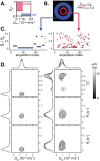This is a preprint.
In vivo disentanglement of diffusion frequency-dependence, tensor shape, and relaxation using multidimensional MRI
- PMID: 37987005
- PMCID: PMC10659440
- DOI: 10.1101/2023.10.10.561702
In vivo disentanglement of diffusion frequency-dependence, tensor shape, and relaxation using multidimensional MRI
Update in
-
In vivo disentanglement of diffusion frequency-dependence, tensor shape, and relaxation using multidimensional MRI.Hum Brain Mapp. 2024 May;45(7):e26697. doi: 10.1002/hbm.26697. Hum Brain Mapp. 2024. PMID: 38726888 Free PMC article.
Abstract
Diffusion MRI with free gradient waveforms, combined with simultaneous relaxation encoding, referred to as multidimensional MRI (MD-MRI), offers microstructural specificity in complex biological tissue. This approach delivers intravoxel information about the microstructure, local chemical composition, and importantly, how these properties are coupled within heterogeneous tissue containing multiple microenvironments. Recent theoretical advances incorporated diffusion time dependency and integrated MD-MRI with concepts from oscillating gradients. This framework probes the diffusion frequency, , in addition to the diffusion tensor, , and relaxation, , , correlations. A clinical imaging protocol was then introduced, with limited brain coverage and 3 mm3 voxel size, which hinder brain segmentation and future cohort studies. In this study, we introduce an efficient, sparse in vivo MD-MRI acquisition protocol providing whole brain coverage at 2 mm3 voxel size. We demonstrate its feasibility and robustness using a well-defined phantom and repeated scans of five healthy individuals. Additionally, we test different denoising strategies to address the sparse nature of this protocol, and show that efficient MD-MRI encoding design demands a nuanced denoising approach. The MD-MRI framework provides rich information that allows resolving the diffusion frequency dependence into intravoxel components based on their distribution, enabling the creation of microstructure-specific maps in the human brain. Our results encourage the broader adoption and use of this new imaging approach for characterizing healthy and pathological tissues.
Keywords: denoising; diffusion tensor distribution; diffusion time dependency; diffusion-relaxation; human brain.
Figures







Similar articles
-
In vivo disentanglement of diffusion frequency-dependence, tensor shape, and relaxation using multidimensional MRI.Hum Brain Mapp. 2024 May;45(7):e26697. doi: 10.1002/hbm.26697. Hum Brain Mapp. 2024. PMID: 38726888 Free PMC article.
-
In vivo rat brain mapping of multiple gray matter water populations using nonparametric D(ω)-R1-R2 distributions MRI.NMR Biomed. 2025 Jan;38(1):e5286. doi: 10.1002/nbm.5286. Epub 2024 Nov 24. NMR Biomed. 2025. PMID: 39582188 Free PMC article.
-
Nonparametric D-R1-R2 distribution MRI of the living human brain.Neuroimage. 2021 Dec 15;245:118753. doi: 10.1016/j.neuroimage.2021.118753. Epub 2021 Nov 28. Neuroimage. 2021. PMID: 34852278
-
A review on investigation of the basic contrast mechanism underlying multidimensional diffusion MRI in assessment of neurological disorders.J Clin Neurosci. 2022 Aug;102:26-35. doi: 10.1016/j.jocn.2022.05.027. Epub 2022 Jun 10. J Clin Neurosci. 2022. PMID: 35696817 Review.
-
Probing brain tissue microstructure with MRI: principles, challenges, and the role of multidimensional diffusion-relaxation encoding.Neuroimage. 2023 Nov 15;282:120338. doi: 10.1016/j.neuroimage.2023.120338. Epub 2023 Aug 19. Neuroimage. 2023. PMID: 37598814 Review.
References
Publication types
LinkOut - more resources
Full Text Sources
